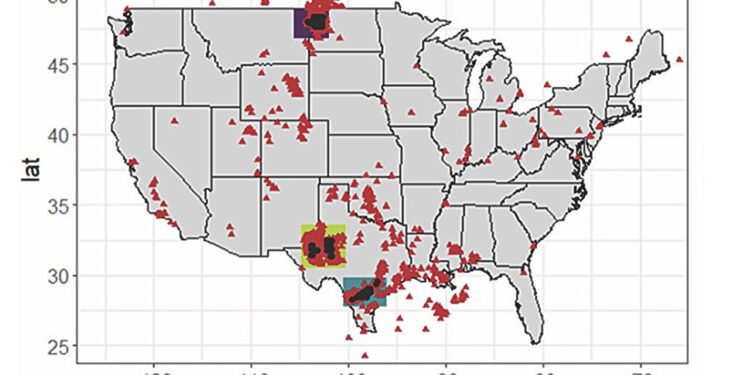Red triangles represent flaring locations as seen by NOAA’s Visible Infrared Imaging Radiometer Suite (VIIRS). Shaded boxes indicate the oil-producing regions surveyed with Bakken in purple, the Permian in yellow, and Eagle Ford in green. Credit: Plant et al. 2024
Flaring or burning natural gas is commonly used in some areas of the United States to dispose of the gaseous byproduct of oil extraction. Flare combustion converts hydrocarbons into carbon dioxide and water, reducing climate impact and on-site natural gas safety concerns, but also produces nitrogen oxides, or NO.X.
NOX– which includes the highly reactive gases nitric oxide and nitrogen dioxide – has a direct and indirect impact on air quality. The Clean Air Act requires the U.S. Environmental Protection Agency (EPA) to regulate nitrogen dioxide, the most common form of NO.Xbecause of its influence on public health and the environment.
Currently, the EPA rates NOX flare emissions using emission factors, a static value multiplied by activity data provided by the flare operator. Despite the spread of flaring practices in the United States, few assessments have directly measured the amount of NOX flaring operations actually produce.
As part of the F3As part of the UEL project, which aims to provide data-driven updates on estimates of oil and gas emissions in the United States, a research team led by the University of Michigan measured NO.X production from real natural gas flares.
The results are published in Environmental science and technology.
The research team collected data in three regions: Eagle Ford in Texas, Permian in Texas and New Mexico, and Bakken in North Dakota, which together produce more than 80% of gas flared volumes in the United States .
A small plane equipped with high-precision instruments flew over these regions at ground level, intercepting the plume of mixed combustion from the flares. NOX Flaring emissions were estimated for each region using emission factors derived from observations from 480 aerial interceptions as well as regional estimates of flaring gas volumes.
“Using an airborne approach allowed us to sample flares over large geographic areas and capture diverse operational conditions, all without the need for ground access to the sites,” said co-author Genevieve Plant, assistant research scientist in climate and space science engineering at the university. the University of Michigan.
“This highlights the importance of measuring emissions sources under real operating conditions,” Plant said.
Although the median emission factor for each region is within the range of values used by the Texas regulatory agency, some eruptions generated NO.X at much higher rates, with 20-30% of flares being responsible for 80% of basin-wide flaring.X emissions. High-emitting flares have raised average emission factors in the Bakken and Permian region to two to three times higher than the value used by the EPA.
“Our measurements show that some eruptions emit excessive amounts of NOXand that these eruptions will have a greater impact on air quality than currently thought,” said co-author Eric A. Kort, associate professor of climate and space science engineering at the University of Michigan.
Reduced air quality could impact the health of on-site workers as well as the health of the 17.6 million Americans who live within a mile of active oil and gas wells. For the regions observed in this study, 500,000 people live within five kilometers of a flare-up, a distance associated with an increased risk of premature birth.
“This work, combined with previous results from F3The UEL project on methane emissions from flaring shows that reducing the volume of gas flared will have greater benefits for climate and air quality than previously thought,” added Kort .
More information:
Genevieve Plant et al, In situ sampling of NOx emissions from natural gas flares in the United States reveals characteristics of heavy-tailed emissions, Environmental science and technology (2024). DOI: 10.1021/acs.est.3c08095
Provided by the University of Michigan College of Engineering
Quote: Airplane-collected natural gas flare samples reveal wide variation in nitrogen oxide emissions estimates (February 7, 2024) retrieved February 7, 2024 from
This document is subject to copyright. Apart from fair use for private study or research purposes, no part may be reproduced without written permission. The content is provided for information only.



